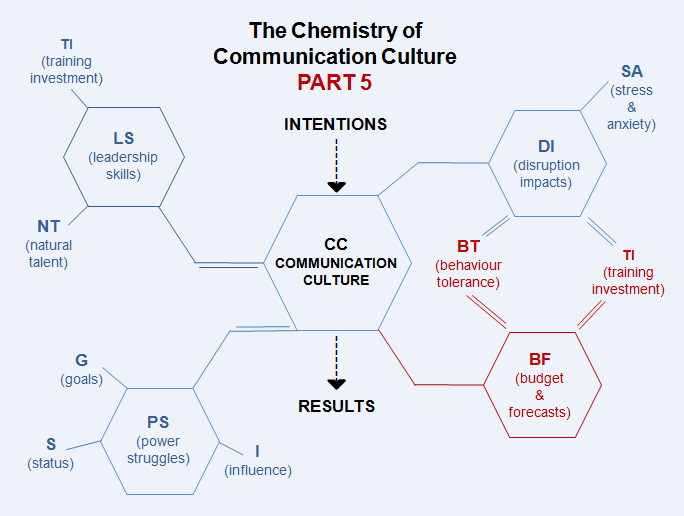First a quick review:
- Part one’s focus was on the central impact of your communication culture chemistry on your organization’s results. (Central line down the middle)
- Part two’s focus was on leadership and how your leaders influence the chemistry of your communication culture. (Top left quadrant)
- Part three’s focus was on power struggles and the impact they have on your people, your organization, and the quality/time/cost factors of your results. (Bottom left quadrant)
- Part four’s focus was on disruptions, from both internal and external factors, that impact your ability to achieve your goals (top right quadrant)
In part 5 the focus is on budgeting and forecasting priorities, two significant factors in the pursuit of your organization’s goals.
The standard approach to meeting goals is to manage the budget, set big goals, and focus on hitting those targets. So budgeting time and money for training is often a low priority. This is a short-sighted approach. The reality is that hitting the target requires people. And people’s ability to perform well together has a great impact on reaching your time/quality/cost goals.
Not all people interpret the stress of meeting forecasts as a positive influence. So overcoming the people factor is a significant contributor to your success. While the specific disruptions that interfere with performance are unique to each environment the results are the same. And the solution is the same. Address the root causes, which are people’s reactions to stress and each other. That’s why you need to focus on helping people manage their responses to their stress and to each other.
Whether we like it or not, the reality is that people live and work in environments they find stressful. To get the best results you need to manage and nurture your unique workplace culture. This is done with communication skills that are informed by an understanding of human nature, behaviour triggers, and strategies for managing interactions. This is the nature of communication culture.
Make it a priority to encourage, support, and motivate positive behaviours while discouraging and addressing negative behaviours. These actions will lead to a healthy culture that pays off in the form of a high-performance, high-commitment environment.
We support your drive to succeed.
When you invest in others, you earn commitment and loyalty. It’s human nature. And human nature, while it may appear to be complex at times, actually operates on very basic principles. How to leverage the priceless understanding of those principles is what communication culture training is all about.
This has been part 5 of The Chemistry of Communication Culture. The full article, covering parts one through five, will be posted soon.
For your reference:
Link to Part 1 of The Chemistry of Communication Culture: https://jameslauber.com/original-content/part-1-the-chemistry-of-communication-culture/
Link to Part 2 of The Chemistry of Communication Culture: https://jameslauber.com/original-content/the-chemistry-of-communication-culture-part-2-leadership-defines-and-reinforces-your-communication-culture/
Link to Part 3 of The Chemistry of Communication Culture: https://jameslauber.com/original-content/the-chemistry-of-communication-culture-part-3-power-struggles-are-impacting-your-communication-culture/
Link to Part 3 of The Chemistry of Communication Culture: https://jameslauber.com/original-content/the-chemistry-of-communication-culture-part-4-disruptions-impact-your-communication-culture/
____________________
May we ask you to please follow the links (below) to our business pages to click the like and follow buttons? Your support will make a big difference and is very much appreciated. Thank you.
LinkedIn/business/GraftOn-SST: https://www.linkedin.com/company/grafton-sst
LinkedIn/business/HotButtonWorkshop: https://www.linkedin.com/company/james-lauber

